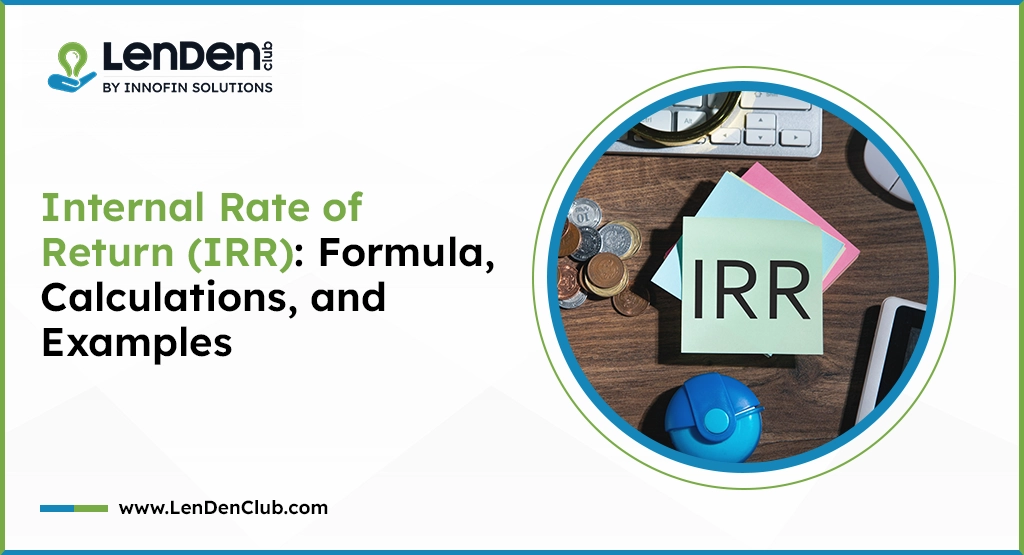Internal Rate of Return (IRR): Formula, Calculations, and Examples

Want to know if your financial assets will actually make money? The Internal Rate of Return (IRR) gives you that answer. This financial metric tells you the annual return rate your portfolio generates.
IRR is the discount rate that makes your project’s net present value equal zero. Simply put, it is the breakeven point where your project neither gains nor loses money.
Every rupee you invest should work harder for you. IRR helps you compare different opportunities and pick the winners. Indian companies use it for capital budgeting, real estate deals, and project evaluations.
How Does Internal Rate of Return Work in Practice?
IRR acts as a report card. A higher IRR means better returns.
Internal Rate of Return considers the timing of your cash flows. Money received today is worth more than money received next year. IRR accounts for this time value.
IRR shows you the exact annual percentage of ROI. When you invest money and get returns over several years, IRR calculates what annual interest rate would give you the same result.
How does this help you? IRR lets you compare any project to simple alternatives like fixed deposits or bonds. If your project has 15% IRR and banks offer 8% FD rates, your project looks attractive.
The calculation considers every rupee that comes in and goes out, plus when each payment happens. This timing matters because early returns are more valuable than late returns.
What is the IRR Formula?
The basic IRR formula looks complex, but the concept is simple:
0 = CF₀ + CF₁/(1+IRR)¹ + CF₂/(1+IRR)² + … + CFₙ/(1+IRR)ⁿ
Where:
- CF₀ = Initial capital (negative number)
- CF₁, CF₂, CFₙ = Future cash flows
- IRR = Internal rate of return
- n = Number of periods
Don’t worry about manual calculations. Excel and financial calculators do the heavy lifting.
How Do You Calculate IRR Step-by-Step?
Manual calculation involves trial and error. You test different discount rates until the NPV equals zero. This process takes time and isn’t practical for most people.
Excel makes IRR calculation simple:
- List your cash flows in a column
- Start with your initial capital as a negative number
- Add subsequent cash flows as positive numbers
- Use the =IRR(range) function
Example calculation:
- Year 0: -₹1,00,000 (initial amount)
- Year 1: ₹30,000
- Year 2: ₹40,000
- Year 3: ₹50,000
Formula: =IRR(B1:B4) = 12.3%
What Excel Functions Calculate IRR?
Excel offers three IRR functions for different scenarios:
- IRR Function: Use this for regular, equal-interval cash flows (monthly, quarterly, yearly). The syntax is =IRR(values, [guess]).
- XIRR Function: Better for irregular payment dates. It considers actual dates, giving more accurate results. Syntax: =XIRR(values, dates, [guess]).
- MIRR Function: Modified IRR that uses different rates for borrowing and reallocation of capital. More realistic than standard IRR. Syntax: =MIRR(values, finance_rate, reinvest_rate).
What Makes a Good IRR in Indian?
IRR must exceed your cost of capital to be worthwhile. If you can earn 7-8% in fixed deposits, your project needs higher than 8% IRR.
Indian market benchmarks:
- Real estate: 12-18% IRR is typical for Indian property
- Indian mutual funds: 12-15% average returns
- Small business projects: IRR above bank loan rates (10-12%)
- Indian corporate projects: IRR above 15% generally acceptable
Compare IRR to Indian alternatives. A 15% IRR beats NSC returns or PPF, but context matters.
How Do You Use IRR for Financial Decisions in India?
Accept projects where IRR exceeds your hurdle rate. For Indian investors, this typically means beating fixed deposit rates plus risk premium.
IRR works best for:
- Business expansion decisions
- Indian real estate
- Equipment purchases for manufacturing
- Startup funding evaluations
Compare multiple projects using IRR rankings. Higher IRR generally means better returns.
What Are the Limitations of Internal Rate of Return Metric?
Several limitations affect its reliability:
- Assumes capital redeployment at IRR rate: This assumption is often unrealistic. You probably can’t reinvest cash flows at the same high rate in Indian markets.
- Ignores project size: A small project with 50% IRR might generate less total profit than a large project with 20% IRR.
- Multiple IRRs possible: Projects with alternating cash flows can produce several IRR solutions.
- Doesn’t consider project duration: Short-term high IRR might be less valuable than long-term stable returns.
How Does IRR Compare to NPV?
IRR and NPV serve different purposes but work together:
NPV shows absolute rupee value your project adds. Positive NPV means profitable project.
IRR shows percentage return rate. Easier to compare different-sized projects.
When they conflict, trust NPV for final decisions. NPV considers project scale and provides clearer value assessment.
Use both metrics together for comprehensive analysis.
How Do You Calculate MIRR and XIRR?
MIRR addresses IRR’s reinvestment assumption by using separate rates for financing and reallocation of money:
Formula: =MIRR(cash flows, finance rate, reallocation rate)
Example: Project has ₹10 lakh initial capital, generates positive cash flows, uses 9% borrowing rate (Indian bank rates) and 6% rate of money reallocation.
XIRR handles irregular dates:
- Capital Amount: ₹5 lakh on January 1st
- Returns: ₹1.5 lakh on March 15th, ₹2 lakh on August 30th, ₹2.5 lakh on December 15th
- Formula: =XIRR(values, dates) produces annualized return
Conclusion
Ready to start using IRR for your finance decisions in India? Begin with simple Excel calculations on smaller projects. As you get comfortable with the basics, you can tackle more complex scenarios using XIRR and MIRR functions.
Although IRR is a powerful tool, it’s not the only tool. Smart Indian investors use multiple metrics to make informed decisions.
Start calculating IRR with everything in mind we discussed above, and watch your financial analysis improve dramatically.